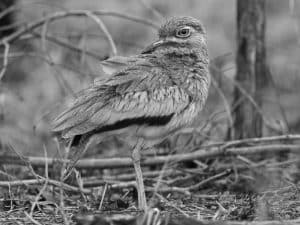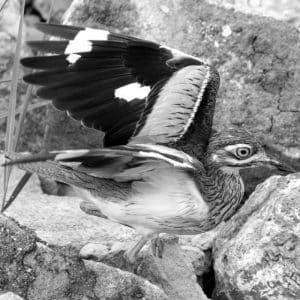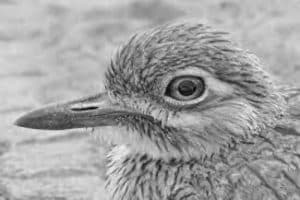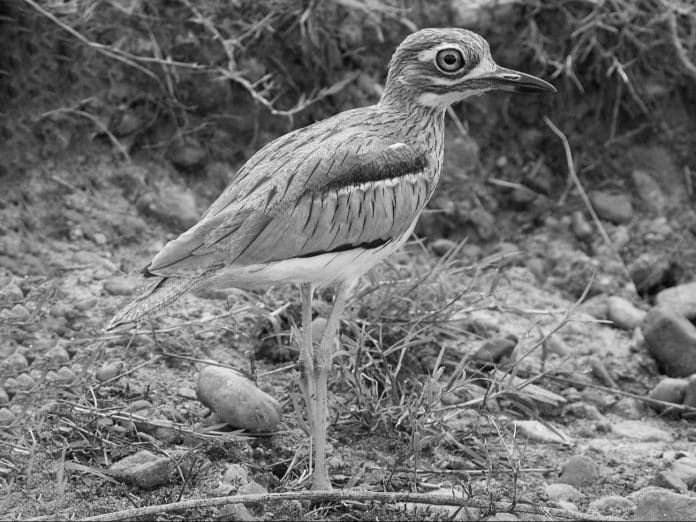Introduction to the Water Thick-Knee
The Water Thick-Knee in Tanzania, scientifically known as Burhinus vermiculatus, is a fascinating bird species found in the beautiful wetlands of Tanzania. These unique birds are known for their distinctive appearance and interesting behaviors, making them a favorite among birdwatchers and nature enthusiasts. In this article, we will explore the habitat, distribution, importance, and conservation status of the Water Thick-Knee in Tanzania.
Habitat and Distribution of the Water Thick-Knee in Tanzania

The Water Thick-Knee is primarily found in the wetlands of Tanzania, particularly along the coastal areas and inland lakes. These birds inhabit a variety of habitats including estuaries, lagoons, swamps, and mudflats. They are well adapted to both freshwater and saltwater environments, making them highly versatile in their choice of habitat.
Tanzania’s wetlands provide an ideal home for the Water Thick-Knee due to their abundant supply of food and suitable nesting sites. The extensive network of wetlands in the country, such as the Rufiji Delta, Lake Victoria, and the Selous Game Reserve, offer a diverse range of habitats for these birds to thrive.
Importance of the Water Thick-Knee in Tanzanian Wetlands
The Water Thick-Knee plays a crucial role in the ecosystem of Tanzanian wetlands. As opportunistic predators, they feed on a variety of invertebrates, small fish, and crustaceans, helping to control their populations and maintain a balanced ecosystem. Their foraging behavior also helps to stir up sediments, improving water quality and creating favorable conditions for other aquatic life.
In addition to their ecological importance, the Water Thick-Knee also serves as an indicator species for the health of wetland ecosystems. Their presence or absence can reflect the overall condition of the wetlands, making them valuable sentinels for monitoring environmental changes and habitat degradation.
Conservation Status and Threats to the Water Thick-Knee

Despite their significance, the Water Thick-Knee faces several threats that have led to a decline in their population and a vulnerable conservation status. Habitat loss due to human activities such as agriculture, urbanization, and infrastructure development is one of the major threats to these birds. Wetland degradation, pollution, and climate change also pose significant challenges to their survival.
Efforts are being made to conserve the Water Thick-Knee in Tanzania through the establishment of protected areas and the implementation of conservation strategies. However, more needs to be done to raise awareness about the importance of wetland conservation and to address the underlying causes of habitat destruction.
Behavior and Characteristics of the Water Thick-Knee
The Water Thick-Knee is a large, ground-dwelling bird with distinct features that make it easily recognizable. It has a stout body, long legs, and a large head with prominent yellow eyes. Its plumage is predominantly brown, providing excellent camouflage in its natural habitat. The bird’s most striking feature is its thick, wedge-shaped bill, which it uses to catch and consume its prey.
Water Thick-Knees are primarily active during the night, spending the day resting or hiding in vegetation near the water’s edge. They are highly territorial and will defend their nesting sites vigorously. When approached by a potential threat, these birds will emit a loud, piercing call to warn off intruders.
Breeding and Nesting Habits of the Water Thick-Knee
Breeding season for the Water Thick-Knee typically occurs during the rainy season when wetland habitats are abundant. These birds are monogamous and form long-term pair bonds. The female lays a clutch of two eggs in a shallow scrape on the ground, usually near water. Both parents take turns incubating the eggs and protecting the nest from predators.
Once the chicks hatch, they are precocial, meaning they are able to move and feed themselves shortly after birth. The parents guide and protect the chicks until they are independent enough to fend for themselves. The breeding success of the Water Thick-Knee is closely tied to the availability of suitable nesting sites and the abundance of food resources.
Research and Monitoring Efforts for the Water Thick-Knee in Tanzania

To better understand the behavior, population dynamics, and conservation needs of the Water Thick-Knee, ongoing research and monitoring efforts are being conducted in Tanzania. These initiatives involve the use of tracking devices, bird banding, and citizen science projects to gather valuable data on the movements, migration patterns, and breeding habits of these birds.
Through these research efforts, scientists and conservationists hope to gain insights into the factors influencing the population trends of the Water Thick-Knee and develop effective conservation strategies to protect their habitats and ensure their long-term survival.
Tips for Birdwatching and Observing the Water Thick-Knee
If you’re a birdwatching enthusiast planning a trip to Tanzania, here are some tips for spotting and observing the fascinating Water Thick-Knee:
- Visit wetland areas: The Water Thick-Knee prefers wetland habitats, so focus your birdwatching activities around lakes, lagoons, and estuaries.
- Be patient and observant: These birds are well-camouflaged and may blend in with their surroundings. Take your time to scan the area and look for any movement or signs of their presence.
- Go out at dusk or dawn: The Water Thick-Knee is most active during the twilight hours. Plan your birdwatching sessions early in the morning or late in the afternoon for the best chances of spotting them.
- Use binoculars or a spotting scope: These tools will help you get a closer look at the Water Thick-Knee without disturbing their natural behavior.
- Respect their space: When observing these birds, make sure to maintain a safe distance and avoid causing any disturbance. The welfare of the birds should always be prioritized over getting the perfect photograph.
Other Wildlife Species Found in Tanzanian Wetlands
Tanzanian wetlands are not only home to the Water Thick-Knee but also harbor a diverse range of other wildlife species. These wetland ecosystems support a rich array of birdlife, including flamingos, herons, storks, and various species of ducks. Crocodiles, hippos, and otters can also be found in these habitats, adding to the biodiversity and ecological importance of the wetlands.
Conclusion and the Need for Conservation Efforts for the Water Thick-Knee
The Water Thick-Knee is an incredible bird species that plays a vital role in the wetland ecosystems of Tanzania. Their presence serves as a reminder of the importance of conserving these unique habitats and the biodiversity they support. To ensure the survival of the Water Thick-Knee and other wetland species, it is crucial to address the threats they face, promote sustainable land use practices, and raise awareness about the importance of wetland conservation.


































